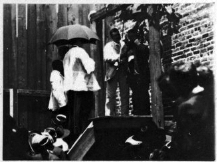An Execution by Hanging (lost execution footage of Edward Heinson; 1898)

|

|
On 6th July 1898, Edward Heinson, who was convicted of a criminal assault on a 14-year-old girl, was executed via hanging at a county jail yard in Jacksonville, Florida. His hanging was recorded by the American Mutoscope Company and distributed as An Execution by Hanging, becoming the second earliest known instance of a filmed legitimate execution.
Background
Edward Heinson was an African American man who, prior to 6th July 1898, was arrested on suspicion of criminal assault on a 14-year-old white girl.[1][2] While Heinson pleaded not guilty, he was eventually convicted and sentenced to execution in a county jail yard in Jacksonville, Florida.[3][4][5][2] Heinson maintained his innocence to the end; despite this, he claimed he was "willing to hang" for "my soul is saved and I am free of all my sins".[2] Heinson's hanging was originally supposed to have been conducted privately.[2] However, upon hearing word of the man's impending execution, many Jacksonville citizens quickly made their way to the vicinity.[2] The Jacksonville Sheriff Broward attempted to limit attendance, including by forbidding almost all women entry to the jail yard.[2] The only exception, despite Broward's strong discouragement that she witness it, was Heinson's victim, as she was "determined to witness the execution of her assailant."[2]
Meanwhile, American Mutoscope Company's Arthur Marvin was living in Tampa, awaiting news about the impending Spanish-American War, which he was keen to capture on film.[6] Marvin was then informed that an execution was to occur in Jacksonville on 6th July 1898.[6][1] He along with other American Mutoscope Company employees sought to gain permission to film the event, which was granted.[6][2] Their camera would be situated within the jail yard, giving the best possible view of the execution.[6] Marvin's comments and the AMB Picture Catalogue 1902 claim that their recording was then the only instance of a filmed legitimate execution.[6][3] In actuality, the first recording of a real execution occurred on 17th December 1897, featuring the hanging of convicted child murderer William Carr.[6][2]
The Execution
Marvin's film began with Heinson, after being escorted by clergymen, ascending to the platform.[3][4][6][2] After the executioner places a black cap and wraps a noose around Heinson's neck, the prisoner is dropped and left to hang.[3][4][6][2] The film ends before Heinson passed away, with his death by strangulation taking around 15 minutes.[2][1] Upon being dropped, the riotous crowd began charging towards the body to confirm the man's death.[2] A policeman, aghast by the scenes, reprimanded the crowd to step back, respect the fact a death had occurred in front of them, and disparaged their actions by comparing them to "seeing an ox killed".[2] After filming the ordeal, the American Mutoscope & Biograph Company titled the footage as An Execution by Hanging, and provided viewing exhibitions across the United States.[2][3][4] According to the AMB Picture Catalogue 1902, the film was 51 feet in length.[3] However, the Museum of Modern Art claims the production was actually extended to 290 feet.[7] Regardless, the film proved commercially successful, with public viewings still possible by 1902.[3][2] Most viewers were probably not informed of Heinson's background.[2]
An Execution by Hanging has been analysed as an example of early filmmaking's fascination with death and other exploitation topics, and its connection with racial tensions in America.[8][9][2][6] For instance, Controversial Cinema cited the film as demonstrating the United State's fascination of seeing physical violence against African Americans.[8] The film's subject matter, as well as its alternative title of Execution of Negro at County Jail, Jacksonville, Fla,[10][6] are also cited in Controversial Cinema and Film Censorship in America as reflecting the values of a racist American culture.[8][9]
Similarly, Lynching and Spectacle believed that the film enabled one to "project their own narrative of black crime and white retribution onto the picture."[2] The film was also compared to The Hanging of William Carr; the latter film received severe criticism for sensationalising the execution, particularly the unruly spectacle it had presented.[2][6] It is unclear whether An Execution by Hanging faced similar scorn, and if not, whether The Hanging of William Carr only received backlash in comparison for featuring the hanging of a white prisoner.[2] However, Lynching and Spectacle theorises that An Execution by Hanging's showcase alongside films presenting other spectacles lessened its impact in Southern states, removing its local connection and presenting the footage as mere entertainment.[2] Regardless, Lynching and Spectacle believed the two earliest instances of filmed legitimate executions reflected the "cultural power of lynching" based on the public spectacle it creates.[2][6] Beyond the Living Dead also believed the film boosted a pro-lynching agenda across America.[5]
Availability
At least one complete Mutoscope Reel of the film still exists.[10] On 20th September 2015, Live Auctioneers conducted a Potter & Potter Auctions public bidding of the reel, estimating its value to be around $1,500-$2,500.[10] The copy was eventually sold for $3,600 to a private collector, making it one of the most expensive Mutoscope Reels sold on the website.[10] No other copies are believed to exist, and no footage is publicly available.[11] Thus, the only definite means of obtaining the reel depends on whether the private collector is willing to publicly share it. As of the present day, only a few stills are publicly viewable.[7][10] Note that this film should not be confused with the available 1905 film also titled An Execution by Hanging, which featured a re-enactment of Mary Rogers' execution.[12]
Gallery
Image
External Link
References
- ↑ 1.0 1.1 1.2 M.E. Grenander Special Collections & Archives listing Heinson as executed on 6th July 1898 in Florida. Retrieved 21st Mar '23
- ↑ 2.00 2.01 2.02 2.03 2.04 2.05 2.06 2.07 2.08 2.09 2.10 2.11 2.12 2.13 2.14 2.15 2.16 2.17 2.18 2.19 2.20 2.21 2.22 Lynching and Spectacle providing a detailed overview of Heinson's conviction and execution, and comparing the film to The Hanging of William Carr. Retrieved 21st Mar '23
- ↑ 3.0 3.1 3.2 3.3 3.4 3.5 3.6 AMB Picture Catalogue 1902 summary of An Execution by Hanging. Retrieved 21st Mar '23
- ↑ 4.0 4.1 4.2 4.3 American Film Institute listing of An Execution by Hanging. Retrieved 21st Mar '23
- ↑ 5.0 5.1 Beyond the Living Dead summarising the film and claiming it supported a pro-lynching agenda. Retrieved 21st Mar '23
- ↑ 6.00 6.01 6.02 6.03 6.04 6.05 6.06 6.07 6.08 6.09 6.10 6.11 Corporeality in Early Cinema summarising the film and its alternative title, and containing Marvin's quote regarding filming it. Retrieved 21st Mar '23
- ↑ 7.0 7.1 Museum of Modern Art stating the film was 290 feet and providing a few stills. Retrieved 21st Mar '23
- ↑ 8.0 8.1 8.2 Controversial Cinema analysis of the film in terms of reflecting fascination of violence against African Americans and reflecting racist US values. Retrieved 21st Mar '23
- ↑ 9.0 9.1 Film Censorship in America stating the film reflected the racial tension faced in America. Retrieved 21st Mar '23
- ↑ 10.0 10.1 10.2 10.3 10.4 Live Auctioneers listing of a Mutoscope Reel that sold for $3,600. Retrieved 21st Mar '23
- ↑ Films By The Year listing the film as lost (based on adding "An Execution by Hanging" in "Search Title"). Retrieved 21st Mar '23
- ↑ Lynching and Spectacle summarising the 1905 film titled An Execution by Hanging. Retrieved 21st Mar '23

